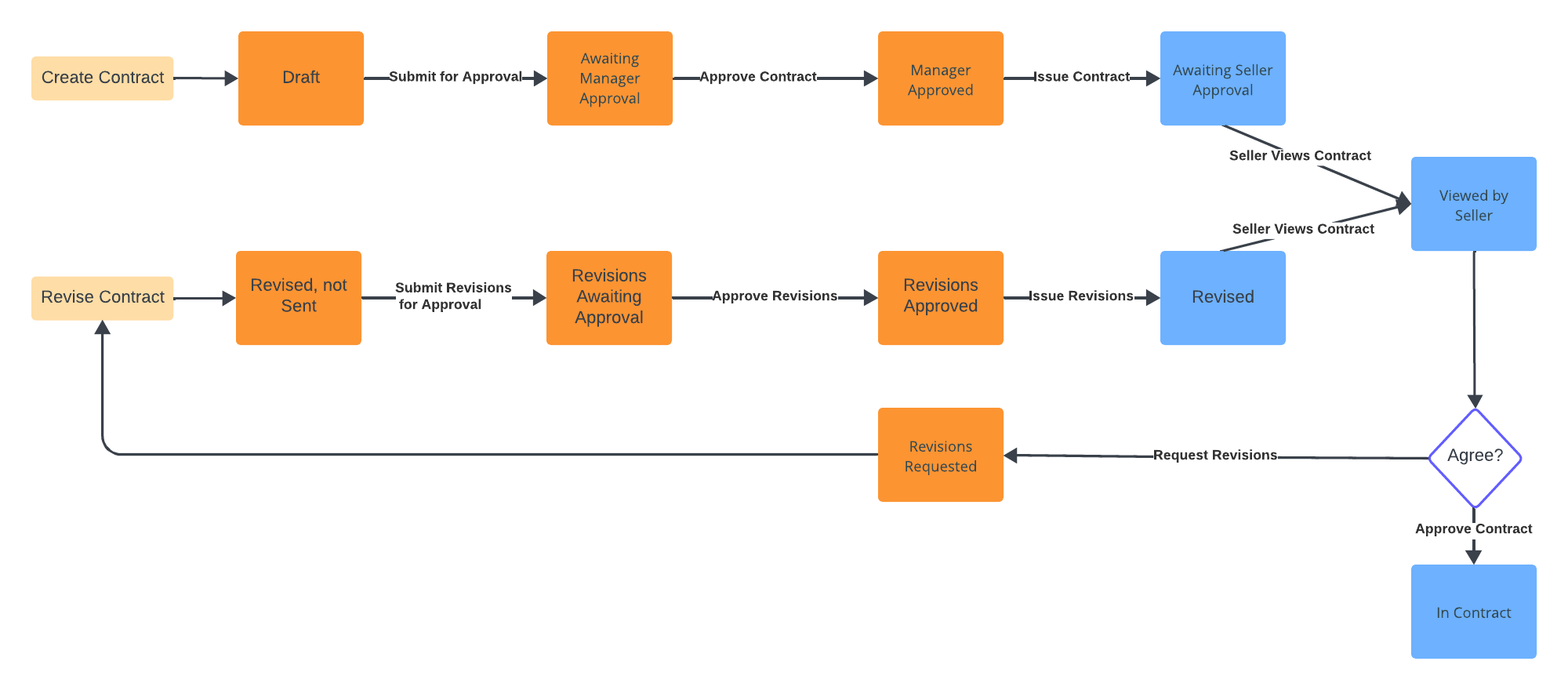Buyer: How do I create a new contract?
Create a new contract from an RFP
In order to create a new contract(s), to proceed to contract from an RFP, first navigate to your RFP Dashboard (click RFPs under the RFP menu), and then click Compile under the Action column for the desired RFP.

Click + Create Contracts above the grid.

Create a new contract from your Contract Dashboard
A new contract can also be created from your Contract Dashboard. To do so, first, navigate to your Contract Dashboard (click Contracts under the Buy menu). Once you are on the dashboard, click on 'Create New Contract'.

Create a new contract from the navigation menu
In addition, a new contract can be created by clicking Create New Contract under the Buy menu.

You will then be taken to the Create Contract page. For more information on filling out the Create Contract page, please see below.
General Contract Information
The first section that will need completed is the General Contract Information section. The amount of information that is auto-populated on the contract will vary depending on which option the contract is based on. Many of the requested details are self- explanatory. As for the various codes (Client, Brand, Agency, Vendor, Market, Source) that are requested, these fields are used by agencies who upload contracts into their billing system and are set up in the respective Contract Code Management. If your agency does not use these codes, but you notice that some of them are required on the contract, feel free to enter filler data into those fields, such as XXX.
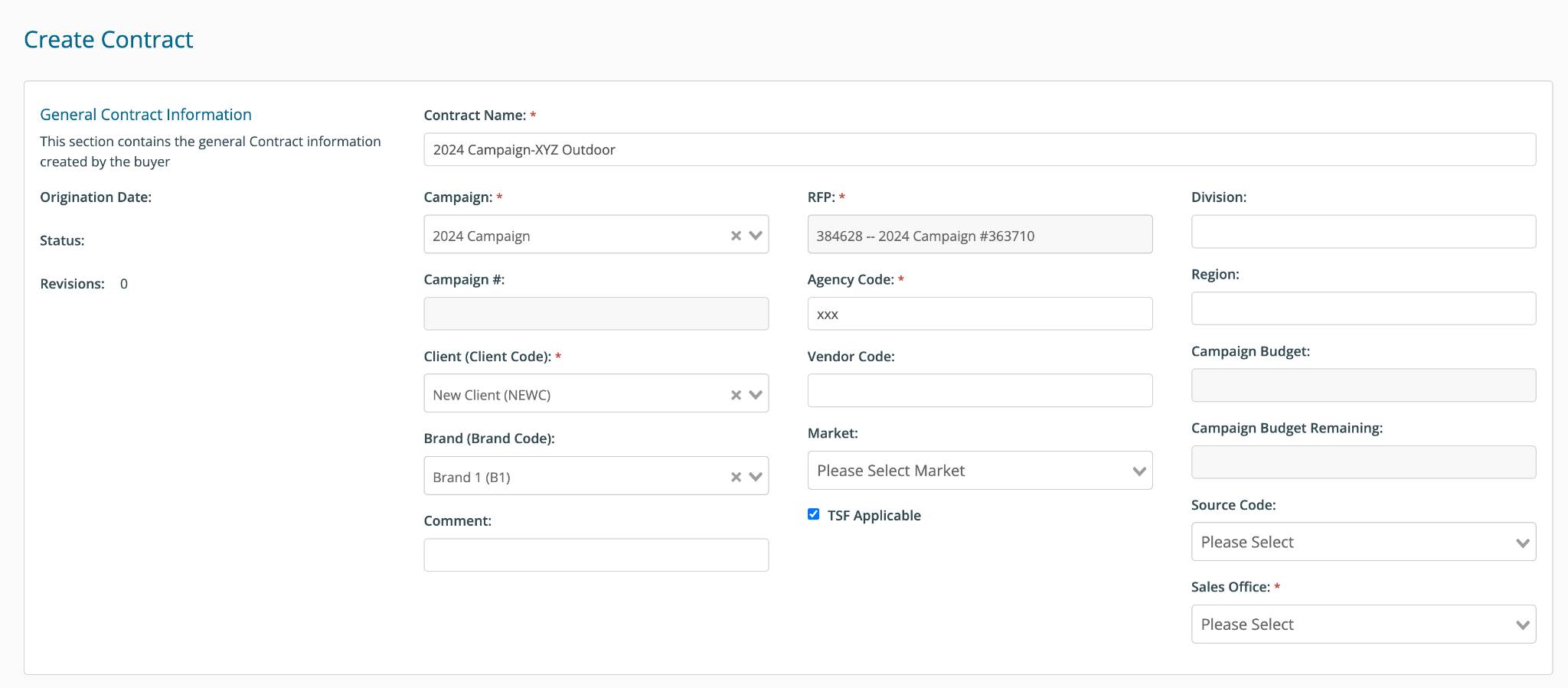
Media Agency & Seller Information
The next step of creating a contract is to ensure that the pre-populated contact information for both the agency and vendor is accurate. If any of the Media Agency Information is incorrect, those contact or company details will need to be updated by clicking the appropriate option under the Account menu. However, the Agency Contact Phone number listed in this section can be modified, in case there is a better phone number to reach a particular agency contact for the contract.
As for the Media Seller Information, if anything is missing or incorrect please reach out to have the vendor update their company information under the Account menu. When selecting Contract Recipients and PI Recipients, if the sales representative you are working with is not listed, please click on the Add Recipient button to get them added.
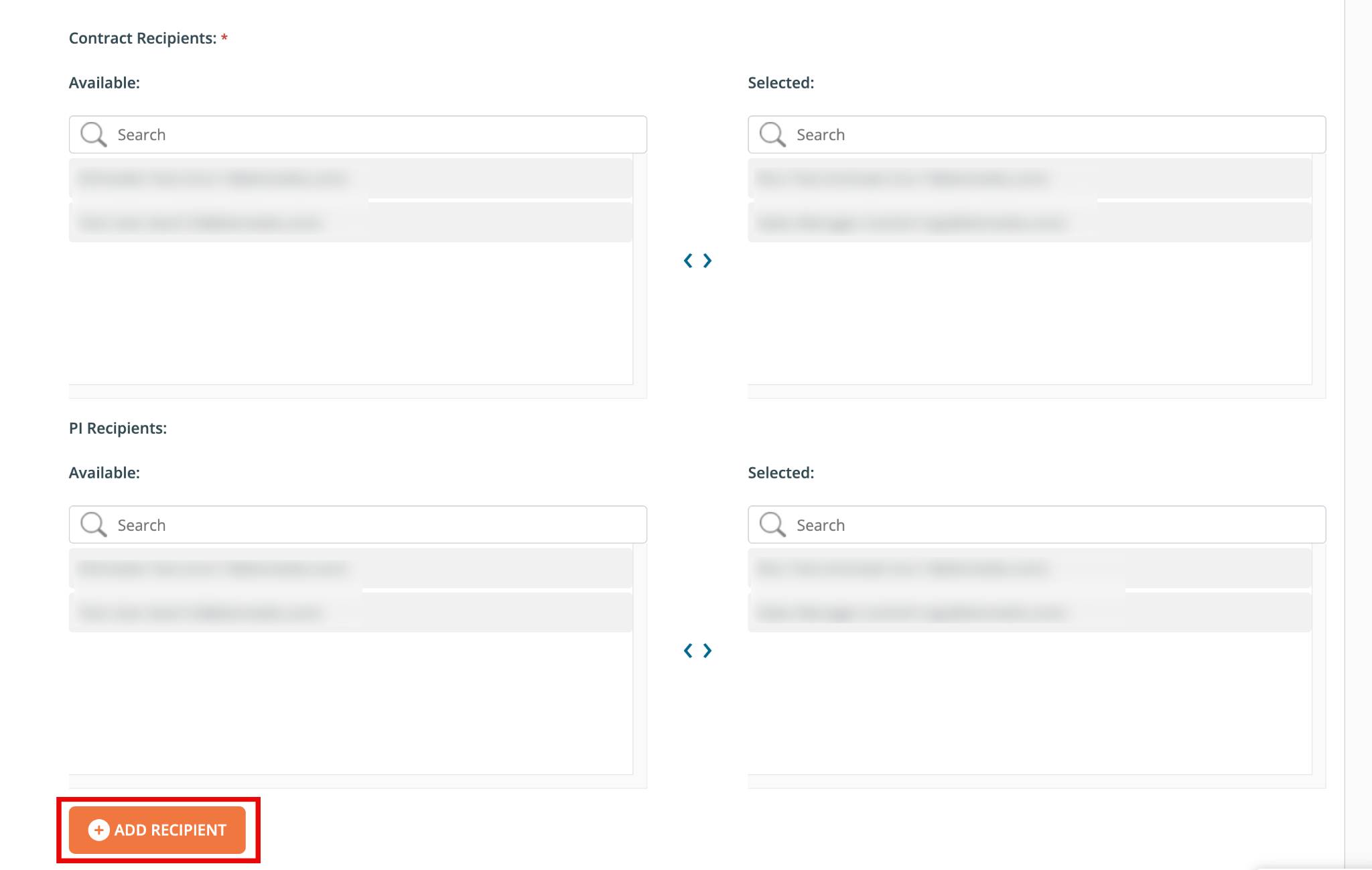
Contract Terms
Next, you can select the terms and conditions that you would like to include in the contract. Clicking on 'details' will open a pop-up box of those specific terms. The options shown for Contract Terms can be managed by clicking Standard Terms under the Settings menu. In addition to the standard term(s) that you select, additional contract terms or supplemental provisions can be entered into the text box to be included in the contract.
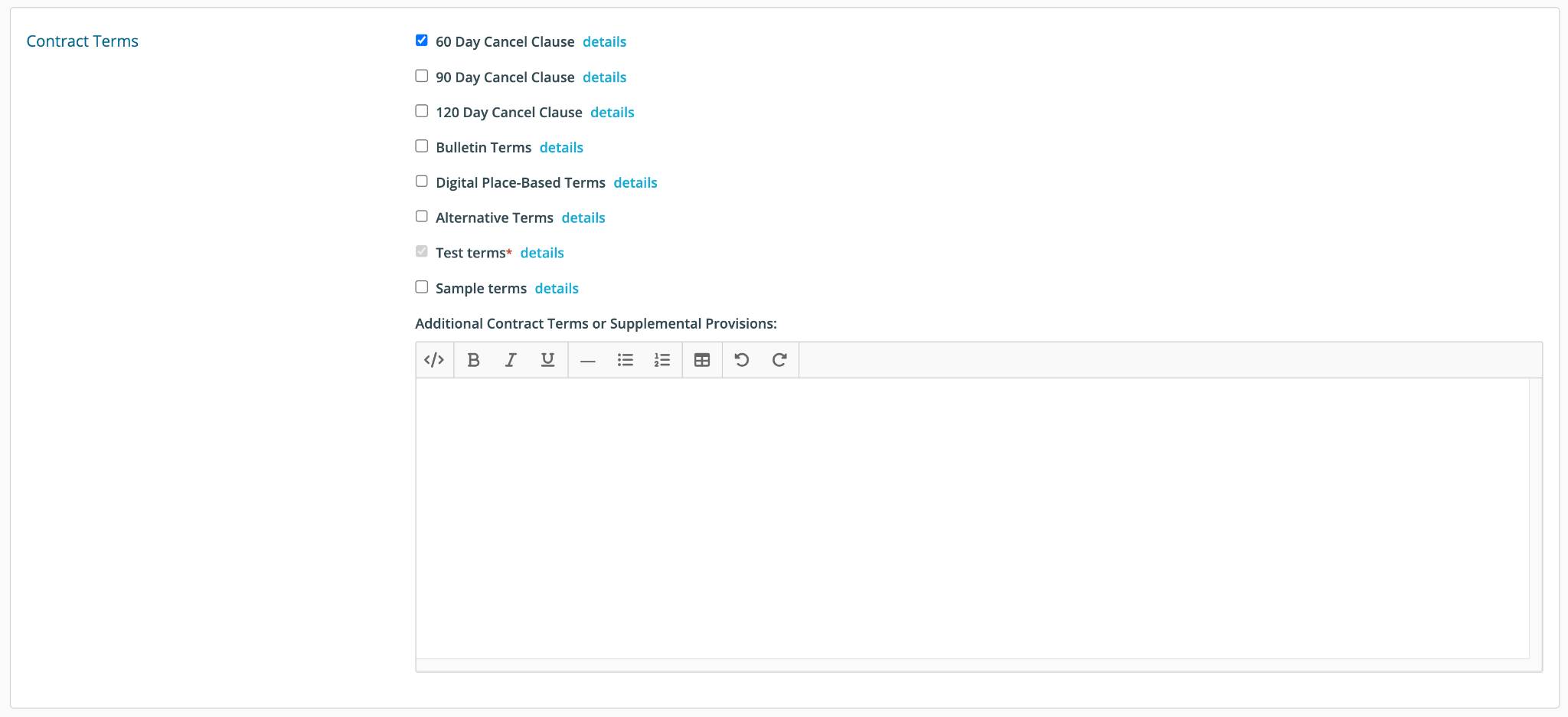
Attachments
After selecting terms, you can add as many attachments as you'd like. Click Browse to select your file, enter a Description, and click Add Attachment. Note: If you have added an attachment to your contract, but you receive an error when attempting to save and create your contract, you will need to re-upload the attachment.

Inventory Information
The Inventory Information section displays details related to the contract's inventory on a line-item basis. Each row is an individual billing line item. Information should be entered at the billing cycle level.

1) Add/Change/Delete
The Add/Change/Delete feature tells your billing software how to handle changes per line item. This section only pertains to you if you work with a billing software.
- Add- Indicates the unique line item will be added to the grid for the first time.
- Change- Indicates that this line item previously entered in the grid is being updated.
- Delete- Indicates that the specific line item is going to be removed from the grid. When working with MBOX please indicate the line to $0.
2) # of Cycles
The # of Cycles will be determined based off the "Cycle Type" and Start/End Dates. In DOmedia, the system will automatically calculate the "# of Cycles" based off the "Start/End Dates" and "Cycle Type".
3) Cycle Type
The Cycle Type determines what length of time the line item will be in contract. Most common Cycle Type is 4-Week. Other commonly used types are 1-Week and days. A unique feature in DOmedia, if you fill in the the # of cycles, the cycle type, and the start date it will automatically determine the end date.
4) Net Media Cost Where you will input the main type of cost. This will push to your billing system.
*TIP: You will need to provide at least the Inventory # or the Geopath # in the grid. Including the Start and End Date for each line item will be needed as well.
*Tip: Unique Record ID is auto generated, never editable.
5) Estimate #
Estimate # is a unique identifier that matches up with your billing system. The Estimate # in the top right will auto-populate if an Estimate # was entered on the related campaign. You can use a button to populate the entire contract with the Estimate # on the campaign by clicking on +Actions and then Fill Estimate.
6) Format Code
Contract Format Code is DOmedia's interface for maintaining and matching out-of-home formats/inventory types with your respective billing systems format codes. (For example: DOmedia says the asset is a Poster, your system may say Billboard). Here is a support article that goes into more detail on how you use Contract Format Codes. Click Here.
7) Additional Cost
Additional cost is a great place to add any other type of charge to the line item. Note some additional billing needs to be on a separate line.
8) Cost Type (If applicable)
Production or media buy. You'll be able to select which type needs to be associated with the line item. Note per some billing systems, production cost needs to be on a separate line.
Tip: Some contracts may have a "Cost 2" column that will be required to be filled in. If applicable please make sure to fill "Cost 2" in.
9) Market Code
Contract Market Code is DOmedia's interface for maintaining and matching geographical markets with your respective billing system market codes for contracting purposes. Here is a support article that goes into more detail on how to use Contract Market Codes. Click here.
10) Brand
Input the client brand for which this contract is associated. Brand is the product once you come to the contact page. If the Brand was indicated on the campaign, you can populate the entire contract with the Brand by clicking +Actions and then Fill Brand.
Once you have confirmed that the data is correct, you can click Save and Review to save the contract and be taken to the View Contract page, or you can click Save to simply save the contract and continue editing.
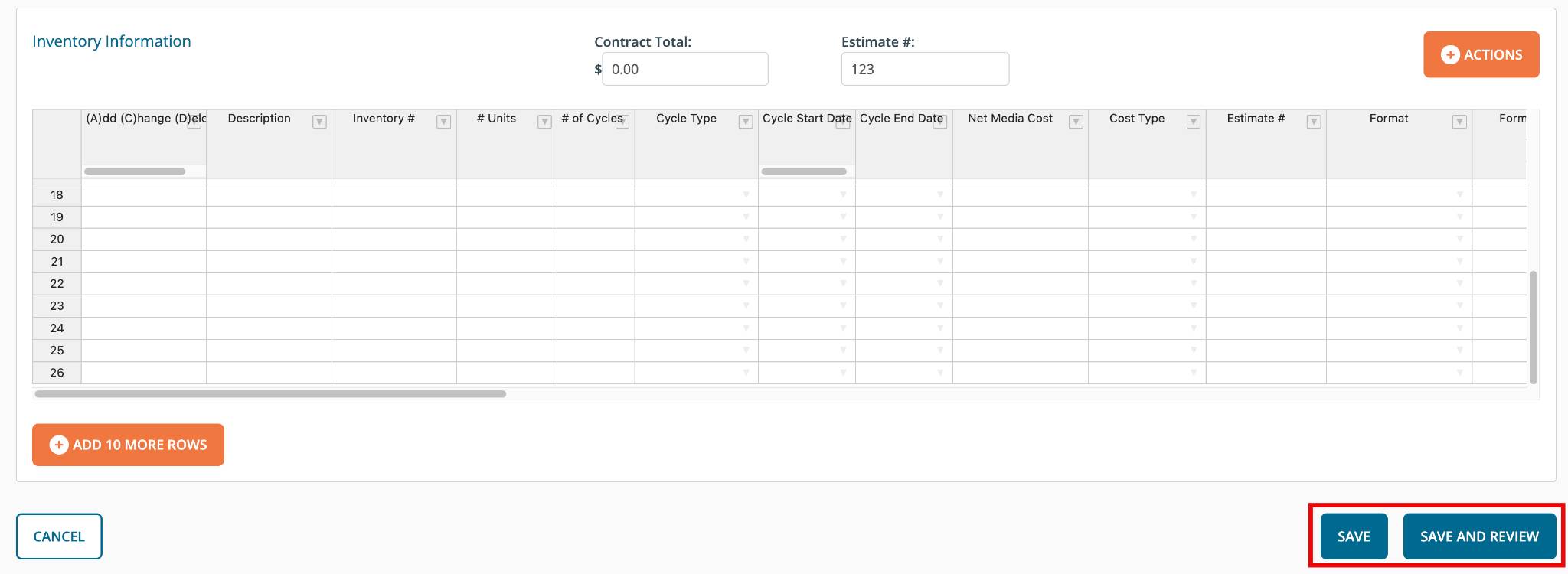
Issuing your contract is the next step after you have created it. Contracts in the 'Draft' or 'Revised, Not sent' will need to be approved and then Issued. Once you have finished making updates to your contract, you can click Submit for Approval at the top when viewing the contract.

If you have contract approval levels set up at your agency, this will trigger an email to a manager or user who has the appropriate budget approval level to approve your contract. The status of the contract will change to Awaiting Manager Approval and will appear highlighted in red in the Contract Dashboard. Once the manager has reviewed and approved the contract, you will receive an email notification and the status will change to Manager Approved.
However, if you do see the Approve Contract button pop up after submitting, that means you can approve immediately and issue the contract yourself.

Click Issue Contract at the top to send this contract over to the vendor - they will receive an email notification with a link to the contract. The contract status of "Awaiting Seller Approval" tells you have successfully issued a contract to the vendor. Once revisions are requested or the contract is approved by the vendor, you will be notified as well.
Please note that additional steps may be needed depending on if your agency is tied to a billing system. Separate documentation is available related to those steps.
